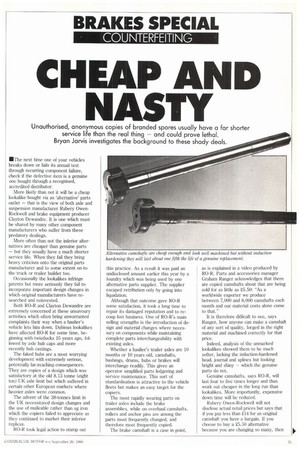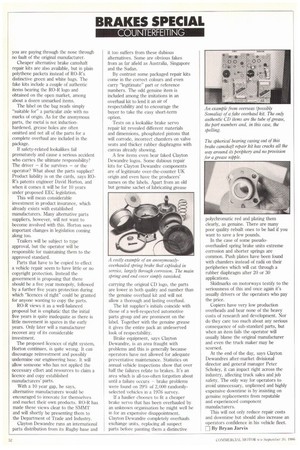CHEAP AND NASTY
Page 53

Page 54

If you've noticed an error in this article please click here to report it so we can fix it.
Unauthorised, anonymous copies of branded spares usually have a far shorter service life than the real thing — and could prove lethal. Bryan Jarvis investigates the background to these shady deals.
EThe next time one of your vehicles breaks down or fails its annual test through recurring component failure, check if the defective item is a genuine one bought through a recognised, accredited distributor.
More likely than not it will be a cheap k)okalike bought via an 'alternative' parts outlet — that is the view of both axle and suspension manufacturer Rubery OwenRockwell and brake equipment producer Clayton Dewandre. It is one which must be shared by many other component manufacturers who suffer from these predatory dealings.
More often than not the inferior alternatives are cheaper than genuine parts — but they usually have a much shorter service life. When they fail they bring heavy criticism onto the original parts manufacturer and to some extent on to the truck or trailer builder too.
Occasionally the lookalikes infringe patents but more seriously they fail to incorporate important design changes in which original manufacturers have researched and reinvested.
Both RO-R and Clayton Dewandre are extremely concerned at these unsavoury activities which often bring unwarranted complaints their way when a haulier's vehicle lets him down. Dubious lookalikes have affected RO-R for some time, beginning with twistlocks 15 years ago, followed by axle hub caps and more recently hub castings.
The faked hubs are a most worrying development with extremely serious, potentially far-reaching consequences. They are copies of a design which was satisfactory at the old 8.13 tonne (eight ton) UK axle limit but which suffered in certain other European markets where heavier axles were common, The advent of the 38-tonnes limit in the UK necessitated design changes and the use of malleable rather than sg iron which the copiers failed to appreciate as they continued to market their inferior replicas.
RD-R took legal action to stamp out this practice. As a result it was paid an undisclosed amount earlier this year by a foundry which was being used by one alternative parts supplier. The supplier escaped retribution only by going into liquidation.
Although that outcome gave RO-R some satisfaction, it took a long time to repair its damaged reputation and to recoup lost business. One of RO-R's main selling strengths is the introduction of design and material changes where necessary on components while maintaining complete parts interchangeability with existing axles.
Whether a haulier's trailer axles are 10 months or 10 years old, camshafts, bushings, drums, hubs or brakes will interchange readily. This gives an operator simplified parts ledgering and service maintenance. This sort of standardisation is attractive to the vehicle fleets but makes an easy target for the copiers.
The most rapidly wearing parts on trailer axles include the brake assemblies, while on overhaul camshafts, rollers and anchor pins are among the parts most frequently changed, and therefore most frequently copied.
The brake camshaft is a case in point, as is explained in a video produced by RO-R. Parts and accessories manager Graham Ranger acknowledges that there are copied camshafts about that are being sold for as little as 25.50: "As a worldwide exporter we produce between 7,000 and 8,000 camshafts each month and our material costs alone come to that."
It is therefore difficult to see, says Ranger, how anyone can make a camshaft of any sort of quality, forged in the right material and machined correctly for that price.
Indeed, analysis of the unmarked lookalikes showed them to be much softer, lacking the induction-hardened head, journal and splines but looking bright and shiny — which the genuine parts do not.
Genuine camshafts, says RO-R, will last four to five times longer and thus work out cheaper in the long run than lookalikes. More importantly, expensive down time will be reduced.
Rubery Owen-Rockwell will not disclose actual retail prices but says that if you pay less than 214 for an original camshaft you have a bargain. If you choose to buy a 25.50 alternative
because you are changing so many, then OP'
you are paying through the nose through no fault of the original manufacturer.
Cheaper alternative brake camshaft repair kits are also available, but in plain polythene packets instead of RO-R's distinctive green and white bags. The fake kits include a couple of authentic items bearing the RO-R logo and obtained on the open market, among about a dozen unmarked items.
The label on the bag reads simply "suitable for" a particular axle with no marks of origin. As for the anonymous parts, the metal is not inductionhardened, grease holes are often omitted and not all of the parts for a complete overhaul are included in the package.
If safety-related lookalikes fail prematurely and cause a serious accident who carries the ultimate responsibility? The driver — if he survives — or the operator? What about the parts supplier? Product liability is on the cards, says ROR's patents engineer David Horton, and when it comes it will be for 10 years under proposed EEC legislation.
This will mean considerable investment in product insurance, which already exists with established manufacturers. Many alternative parts suppliers, however, will not want to become involved with this. Horton sees important changes in legislation coming along too.
Trailers will be subject to type approval, but the operator will be responsible for maintaining them to the approved standard.
Parts that have to be copied to effect a vehicle repair seem to have little or no copyright protection. Instead the government is proposing that there should be a five year monopoly, followed by a further five years protection during which "licences of right" could be granted for anyone wanting to copy the parts.
RO-R views it as a well-balanced proposal but is emphatic that the initial five years is quite inadequate as there is little movement in spares in the early years. Only later will a manufacturer recover any of its considerable investment.
The proposed licences of right system, Horton continues, is quite wrong. It can discourage reinvestment and possibly undermine our engineering base. It will allow someone who has not applied the necessary effort and resources to claim a licence and copy established manufacturers' parts.
With a 10 year gap, he says. alternative manufacturers would be encouraged to innovate for themselves and market their own products. RO-R has made these views clear to the SMMT and will shortly be presenting them to the Department of Trade and Industry.
Clayton Dewandre runs an international parts distribution from its Rugby base and it too suffers from these dubious alternatives. Some are obvious fakes from as far afield as Australia, Singapore and the Sudan.
By contrast some packaged repair kits come in the correct colours and even carry "legitimate" part or reference numbers. The odd genuine item is included among the imitations in an overhaul kit to lend it an air of respectability and to encourage the buyer to take the easy short-term option.
'tests on a lookalike brake servo repair kit revealed different materials and dimensions, phosphated pistons that will corrode, incorrect chamfers on valve seats and thicker rubber diaphragms with canvas already showing.
A few items even bear faked Clayton Dewandre logos. Some dubious repair kits for Clayton Dewandre components are of legitimate over-the-counter UK origin and even have the producers' names on the labels. Apart from an old but genuine sachet of lubricating grease carrying the original CD logo, the parts are lower in both quality and number than the genuine overhaul kit and will not allow a thorough and lasting overhaul.
The kit supplier's initials coincide with those of a well-respected automotive parts group and are prominent on the label. Together with the genuine grease it gives the entire pack an undeserved look of respectability.
Brake equipment, says Clayton Dewandre, is an area fraught with problems and this is generally because operators have not allowed for adequate preventative maintenance. Statistics on annual vehicle inspections show that over half the failures relate to brakes. It's an area which is all-too-often forgotten about until a failure occurs — brake problems were found on 29% of 2,000 randomlyselected vehicles in a 1976 survey.
If a haulier chooses to fit a cheaper brake servo that has been overhauled by an unknown organisation he might well be in for an expensive disappointment. Clayton Dewandre completely overhauls exchange units, replacing all suspect parts before painting them a distinctive polychromatic red and plating them clearly, as genuine. There are many poor quality rebuilt ones to be had if you want to save a few pounds.
In the case of some pseudooverhauled spring brake units extreme corrosion and shorter springs are common. Push plates have been found with chamfers instead of radii on their peripheries which will cut through a rubber diaphragm after 20 or 30 applications.
Skidmarks on motorways testify to the seriousness of this and once again it's usually drivers or the operators who pay the price.
Copiers have very low production overheads and bear none of the heavy costs of research and development. Nor do they care too much about any serious consequence of sub-standard parts, but when an item fails the operator will usually blame the original manufacturer and even the truck maker may be scorned.
At the end of the day, says Clayton Dewandres after-market divisional director and general manager Peter Scholey, it can impact right across the industry, affecting truck sales and job safety. The only way for operators to avoid unnecessary, unplanned and highly expensive downtime is by insisting on genuine replacements from reputable and experienced component manufacturers.
This will not only reduce repair costs and downtime but should also increase an operators confidence in his vehicle fleet. El By Bryan Jarvis
























































































































